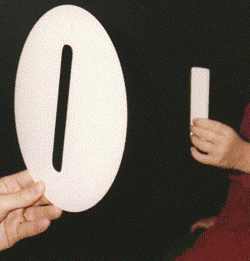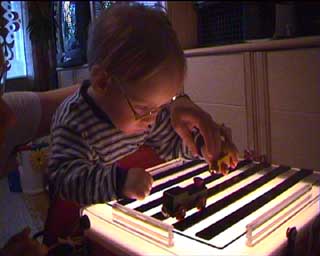LEA Mailbox Game
#254700

The LEA Mailbox Game (#254700) was designed for assessment of visual recognition of line directions. Some children and adults with brain lesions may be able to turn a ‘letter’ (the plastic card simulating a letter) in correct orientation when the task is to drop it through the slot, yet are unable to tell the direction of the slot when no hand function is involved. ‘The hand sees but not the eyes.’
Instructions
If a child or an older person seems to have problems in understanding what is meant with different directions/ orientations, explore the slot of the LEA Mailbox Game in vertical, horizontal and tilted positions using tactile and kinestetic information. The person is taught the concepts 'vertical', 'horizontal' and 'tilted'/'oblique'.
-
Find out with the child how to place his/her hand or a ruler along the slot in different orientations to observe that wrist and finger movements are normal or at least good enough to allow turning of the hand or a ruler into different orientations.
-
Give the white card to the child in an orientation different from the orientation of the mailbox’ slot and ask the child to drop the ‘letter’ through the mailbox’ opening. The movements of the wrist and fingers are observed carefully. If the envelope is turned in correct orientation when approaching the slot there is visual information available for planning the wrist and finger movements (a parietal lobe function). When this is possible go on with a purely visual task.

-
Show the mailbox at about half a meter distance (20 in) and ask the child to place his/her hand, a ruler or a pencil in the same orientation as the slot (Figure). If this is not possible even after several trials or is in part incorrect, purely visual analysis of orientation of lines is difficult or impossible (temporal lobe function). - Many children find this task not meaningful and try to drop the object through the slot as previously. In that case use an adult (pretending not to know what to do) to turn the object and ask the child to tell, when it is in the same orientation as the slot.
If basic recognition of orientation is affected, perception of geometric forms and line drawings may be difficult and needs to be carefully assessed.
If the child does not have the concept of direction of lines, use the visuotactile broad, black velcro lines (on a lightbox if needed), and drive small cars on them turning the lines in different directions. When the child can move the car along the velcro line, turn the board so that the velcro lines face downwards and at the same time, rotate the lines 90 degrees. If the child continues moving the car in the previous direction, i.e. across the lines instead along the lines, the function is based on motor memory and not on visual information.

[ Instructions I Paediatric Vision Tests I Vision Tests ]
This document was last modified on